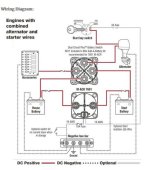All good discussion.
I've been debating myself as to whether I need (or want) a 3 bank charger, but 15a seems a reasonable output capacity, and the ones I'm looking at seem to be 3 bank chargers. The Promariner Promarine series are smart chargers, so they will divide current between banks, send all current to one bank etc. as necessary. So that still seems like a reasonable choice?
I was wondering whether I even needed to use two banks of the charger, since it seems with the VSR I could just wire one bank of the charger to whichever battery is the closest and both batteries would charge? (The batteries are on opposite sides of the boat, is why I'd be tempted to do this... less leads to run). AGM batteries, if that's relevant.
And now a new question: on a 22 cruiser, where would this charger typically be located? I'm thinking port side battery locker, since that's where I have the most room. I don't see a way to mount it without drilling holes in the side of the boat though (the inside wall of that battery compartment, facing the splash well). This I've never done, and am not entirely comfortable with it, out of water intrusion concerns. Clearly there's a right way to do this... but I don't know it. :wink: Could anyone point me towards an explanation of what I'd need to ensure an absolutely watertight seal around the mounting bolts?
Thanks again for indulging me... I'm sure this is all extremely basic knowledge. All I've owned previously was a Catalina 27 with a shore power system already installed, and while much tinkering was necessary to keep the Atomic 4 behaving, I never cut or drilled any holes, and surprisingly in the 10 years I had her she never needed any electrical work, so I just used everything as it was.
Joe


